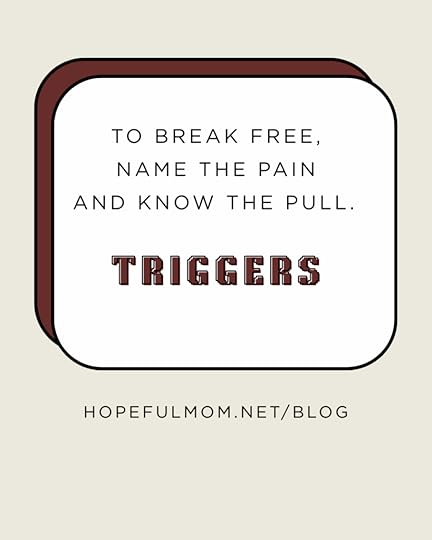BLAST Triggers: What’s Driving Your Teen’s Behavior?
Some run to drugs. Some shop. Some watch pornography.
How do you cope when your anxiety spirals and you’re desperate for relief? What’s your default reaction when triggered?
How about your teen? What sets them off and where do they turn?
I eat. My food of choice was ice cream until stomach problems forced me to give it up. Now it’s Ghirardelli chocolate. The dark chocolate mint squares. (Pause with me and mentally savor this treat.)
In all transparency, I also turn to social media or streaming shows. When my to-do list is out of control or I’ve failed someone close, to numb my brain and stop the incessant negative self-talk, I scroll. Or get lost in a show.
Unfortunately, after I’ve eaten the chocolate and turned the TV off, the problem remains. My list hasn’t magically disappeared, and negative thoughts quickly return.
Name the Pain and Know the PullPinpointing the outside stimuli or emotions that affect us—and our children—is key to recovery.
To overcome compulsive behavior, we must acknowledge its destructive impact and then identify the triggers that compel us to repeat it.
 What Are BLAST Triggers?
What Are BLAST Triggers?BLAST triggers are common. This acronym stands for Bored, Lonely, Angry, Stressed, and Tired.
BoredWe are meant to be active, physically and mentally. Whether working, studying, interacting with friends, or participating in physical activities, our minds and bodies need engagement. When faced with boredom, our children could succumb to an activity they’re conditioned to believe is pleasing, entertaining, or numbing (at least momentarily).
To combat this BLAST trigger, let’s help our teens recognize when they are bored. Ask them to brainstorm a list of things to do when they’re restless. They may want to call a friend, read a book, take a walk, or learn a new hobby like painting, playing the guitar, etc.
LonelyEach of us possesses a basic need to belong. Loneliness leads to sadness, depression, or feelings of emptiness. These can trigger self-medicating behaviors like watching pornography or too much screen time.
To combat this trigger, help your child find where they fit in. Schedule family meals and activities. Include them in discussions. Encourage them to try various after school organizations, sports, or clubs.
AngryAnger instigates irresponsible behavior. When we don’t have healthy methods of dealing with anger, we cope by turning to our vice of choice.
To combat this trigger, help your child identify who they are angry with and why. Then encourage them to forgive and learn methods to diffuse their anger.
Re-direct your child toward a productive pursuit when they feel agitated.
Pinpointing the outside stimuli or emotions that trigger us—and our children—is key to overcoming addiction or compulsive behaviors. BLAST Triggers: What’s Driving Your Teen’s Behavior? #triggers #hopefulmom #parenting
Share on X
We experience an extreme amount of internal and external pressure to perform at a certain level, to behave a particular way, and to fit in with peers. This causes stress. Our instinct is to find a quick way out of the anxious situation—to calm our nerves and ease our discomfort. Unfortunately, many of these coping mechanisms are only temporary fixes and do not address the underlying issue.
To combat this trigger, help your teen understand normal levels of stress and teach them anxiety-reducing strategies like breathing exercises.
TiredOur brains don’t function well when we’re tired. We make irrational and illogical decisions. Someone who is tired may turn to drugs, alcohol, or pornography, believing this will relax their body and help them sleep.
To combat this trigger, help your teen understand the importance of proper sleep. They need 8-10 hours of uninterrupted (no tech in bedrooms!) sleep. For more information on helping your teen sleep better, read Teenagers and Sleep: How Much Sleep is Enough?.
Other TriggersBesides the above-named BLAST triggers, hunger or reminiscent situations may provoke a desire to turn to a vice. Other acronyms for triggers are HALT and SEE.
Hungry
Angry
Lonely
Tired
Social – certain people or situations or feeling peer pressure
Environmental – sights or sounds
Emotional – feelings, like rejected or hurt
Create A PlanWhether its BLAST triggers or others, learn to pause, name the offensive element, and choose a healthy and effective response.
When craving a Ghirardelli, I ask myself if I’m angry, stressed, hurt, or bored. If the answer is yes, I stop to evaluate what happened and (usually) choose to work through the presenting problem rather than drown my sorrow with chocolate.
Healthy responses may take a while to come naturally, but I believe you and your teen can devise a plan to combat triggers effectively.
For specific questions to discern your child’s triggers and more information on combatting triggers, read Understanding Triggers in Pornography Use. For a list of possible trigger-inducing events for parents of a child who’s been exposed to pornography, read Parent Triggers After A Child’s Pornography Exposure.
The above was adapted from a section in Chapter 7 of the book, Sexpectations: Helping the Next Generation Navigate Healthy Relationships.
Note: Sometimes counseling is necessary to overcome compulsive behaviors or addictions.
The post BLAST Triggers: What’s Driving Your Teen’s Behavior? appeared first on HOPEFUL MOM.



